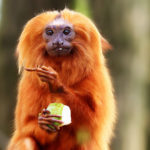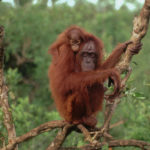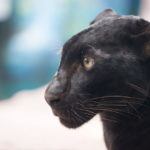Lemurs
 Lemurs are primitive primates, the Latin name of which in translation means “spirit, ghost”. This nickname lemurs owed to a night and secretive way of life. There are 65 species of these animals. A more distant relationship among lemurs with higher apes – monkeys.
Lemurs are primitive primates, the Latin name of which in translation means “spirit, ghost”. This nickname lemurs owed to a night and secretive way of life. There are 65 species of these animals. A more distant relationship among lemurs with higher apes – monkeys.
The appearance and size of lemurs vary widely. In general, these are medium and small animals, in which half of the length of the body is occupied by the tail. The largest lemur vari has a length of 1-1.2 m and a weight of 4 kg, the smallest dwarf lemur is only 17-28 cm long and weighs 60 grams! The lemurs’ body is rather thin and elongated, the fore and hind legs are the same length, the tail is long and straight. In comparison with monkeys, the muzzle of lemurs is more elongated, the ears are small, the eyes of the day species are relatively small, and the night ones are large.
On the muzzle of lemurs there are bunches of sensitive hair – vibrissae (as in a cat), besides their nose is always wet, for this lemurs even isolated in suborder of wet monkeys. All these signs indicate the primitiveness of lemurs. At the same time, they also have typical monkey features – the thumb on the paws is contrasted with the rest (although not so prominent as in the higher primates), the toes of the lemurs grow on their fingers. Only the second finger of the hind limbs grow so-called toilet claws, with which lemurs comb their hair. The coat of lemurs is short, but thick.
The wool is soft and homogeneous, similar to fur. Color can be very diverse, often it is not monochrome, but zoned, that is, different parts of the body are painted in contrasting colors (black, white, gray, red-red). Sexual dimorphism in lemurs is not expressed except for black lemur, in which males are black, and females are red with white cheeks.
Lemurs are a unique group of animals, because with all its species diversity, it lives only in Madagascar and several adjacent islands. Thus, all lemurs are narrow endemics and very vulnerable. The habitats of lemurs are different types of forests from wet jungles to dry sparse forests. Cat lemurs can meet on the slopes of mountains, and crowned lemurs visit the unique area of Madagascar – Tsingi de Bimaraha. At this point the rocks are sharp as razor blades peaks, and these points stick out densely, like a forest. Lemurs manage to jump on these rocks without the slightest damage to their health, but they live in neighboring forests.
The lifestyle of lemurs is very different in different species. Small lemurs live singly and lead a strictly nocturnal lifestyle. These are cautious and secretive animals, which are difficult to track down. Large species live in groups of 10-25 individuals, they are active in the daytime, behave bolder and can visit gardens and city parks without fear of human presence. In small species, a phenomenon unique to primates is observed – hibernation, or rather numbness. Animals fall into this state in the dry season, when juicy feed is in short supply. The stupor lasts for several months, during this period the lemur lives off the fat stores accumulated earlier.
Lemurs are sedentary and occupy permanent sites that guard against the invasion of neighbors. Little is known about the way of life of small species of lemurs, they remain one of the most poorly studied animals. In zoos, dwarf lemurs behave aggressively, although much depends on the individual characteristics of the animal. In the family groups of large lemur species there is a strict hierarchy, with female dominant position in the group. Males are always on second roles and can change the group, while females remain in the mother’s family.
Between neighboring families there can be fights for the territory, during which animals make jumps (they are more frightening and are called to suppress the enemy psychologically), bite each other less often. The boundaries of the territory of lemur are marked by urine. However, lemurs can not be called evil animals, bloody fights do not exist among them, and if internal discipline is observed in a group, its members often show mutual signs of attention – they touch and comb the hair, lick each other. Lemurs publish a variety of sounds (grunting, for example), but their facial expressions are not developed. Unlike monkeys, lemurs do not show impudence and courage, they are timid and meek animals that do not have sharpness.



























